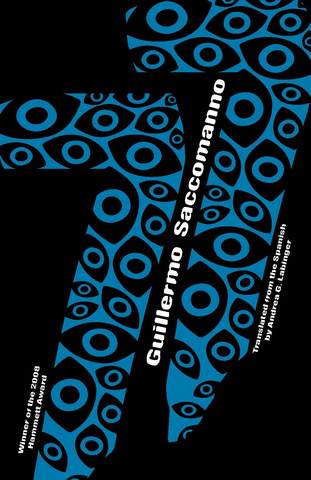77: A Novel by Guillermo Saccomanno
Reviews
By Ross Nervig
Guillermo Saccomanno’s latest novel, 77, is set in Buenos Aires during the titular year of 1977. Argentina is under the thumb of the Videla dictatorship, and the drizzle-drenched days are “cop-colored,” according to the book’s narrator, Professor Gomez. Paranoia and terror abound. Gomez, a gay teacher of literature, attempts to remain inconspicuous while pupils and loved ones are disappeared by government toughs roving the streets in ubiquitous green Falcon cars. When a student is dragged from his classroom, Gomez’s dread compounds, and he begins his dark spiral downward. He develops a “wandering syndrome,” punctuated only by the nameless “pick-ups” and “fast fucks” he seeks out to relieve the creeping suspicion that he is being watched by the government. The professor’s life is further complicated when he hides two political dissidents in his book-filled apartment, made riskier still by his on-again, off-again affair with a chauvinistic cop named Walter.
Just as generations of Latin American writers worked under the shadow cast by García Márquez, today’s authors seem fated to toil under the shadow of Roberto Bolaño. 77 and Bolaño’s late novels share some distinct qualities: the bibliomaniacal paranoia, the scars of dictatorships, a cool approach to sex, the commingling of dread states and dream states, and the fact that almost any form of love is ill-starred. Like many of Bolaño’s works, Saccomanno’s story carries a whiff of noir and a hallucinatory propulsion of sorts. Beyond Bolaño, Gomez’s rat-in-a-cage paranoia brings to mind Raskolnikov from Crime & Punishment. But where Raskolnikov frets over the discovery of the murder he has committed, Gomez’s worries are ambiguous. He fears he is the victim of a conspiracy, but just what that conspiracy is remains occluded. Gomez’s terror is not unwarranted, though. General Videla did preside over a violent Argentinian era, repressing homosexuality with the help of the police.
Professor Gomez also resembles Rachel Cusk’s Faye from her recent Outline Trilogy. When he’s not fidgeting in terror, Gomez acts as a vessel for the stories of individuals he encounters. There’s DeFranco, a poet friend, who rekindles a love affair with his former student in front of her husband, a wheelchair-bound invalid; there’s Diana, the pregnant freedom fighter hiding out in Gomez’s apartment with a gun, as well as a number of other porteños who drop in and out of the professor’s life, burdening him with their woeful stories before vanishing back into the drizzle and wind that plague Saccomanno’s Buenos Aires.
As an exploration of an agitated state of mind, the novel relies on paranoia as its narrative engine. Gomez relates the events of 1977 thirty years later to an unnamed narratee. This choice, at times, imperils the tension of the novel. The reader is supposed to fear for our main character’s life, but if we know that Professor Gomez is alive and well in 2007, how much worry should we devote to the events of ’77? Saccomanno, a two-time winner of the Hammett Prize from the International Association of Crime Writers, seems less interested in solving the many crimes and disappearances that occur throughout the story and more concerned with the investigation of a tender, literary soul trapped in an awful age of oppression and governmental scaremongering. 77 sings a dark song of one man’s struggle to stay human when the inhumane lurks on every corner and the day-to-day reality of his world is curdled by the struggle between unchecked power and subversive acts. One would do well to read this book as warning of history and its insidious repetitions.
Ross Nervig is a writer living in Nova Scotia. From 2012-2017, he served as a founding member of Revolver—a literary arts collective based in St. Paul, Minnestoa. His work has appeared in Kenyon Review, Bluestem Journal, Bayou Magazine, Southwest Review, and Huffington Post. He is currently an MFA Candidate in Fiction at the University of New Orleans. In 2018, he received the University of New Orleans Creative Writing Workshop’s Ernest and Shirley Svenson Award for Fiction.
More Reviews

